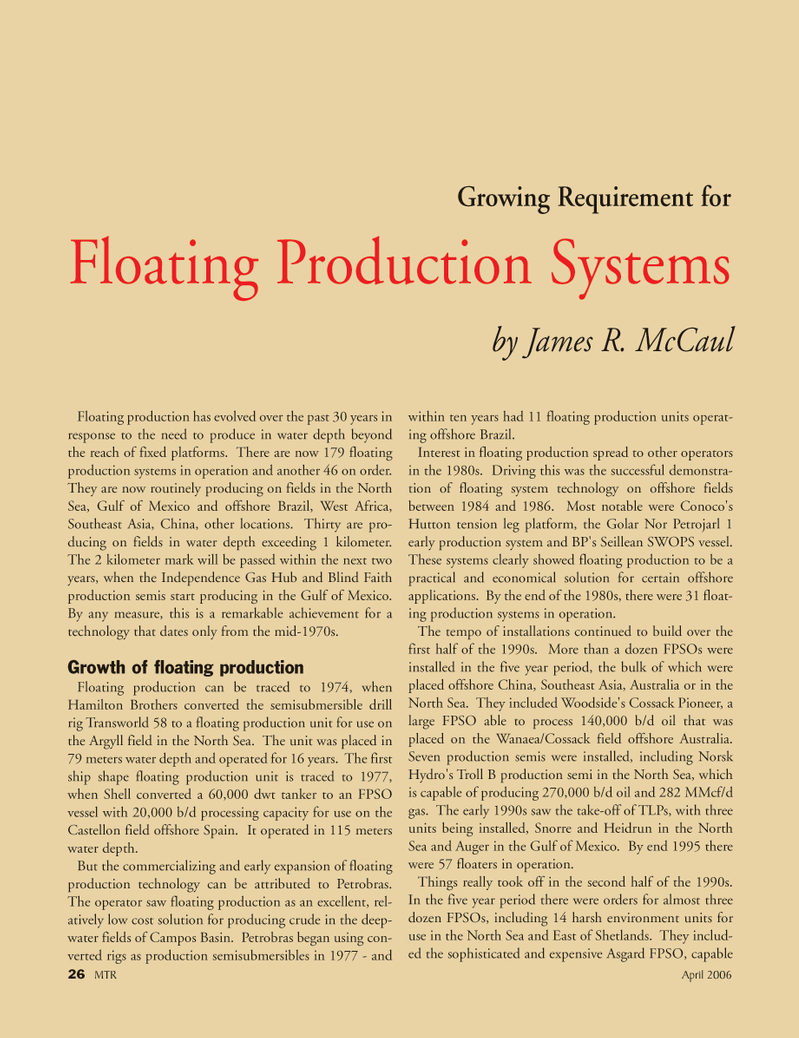
Page 26: of Marine Technology Magazine (April 2006)
The Offshore Technology Edition
Read this page in Pdf, Flash or Html5 edition of April 2006 Marine Technology Magazine
Floating production has evolved over the past 30 years in response to the need to produce in water depth beyond the reach of fixed platforms. There are now 179 floating production systems in operation and another 46 on order.
They are now routinely producing on fields in the North
Sea, Gulf of Mexico and offshore Brazil, West Africa,
Southeast Asia, China, other locations. Thirty are pro- ducing on fields in water depth exceeding 1 kilometer.
The 2 kilometer mark will be passed within the next two years, when the Independence Gas Hub and Blind Faith production semis start producing in the Gulf of Mexico.
By any measure, this is a remarkable achievement for a technology that dates only from the mid-1970s.
Growth of floating production
Floating production can be traced to 1974, when
Hamilton Brothers converted the semisubmersible drill rig Transworld 58 to a floating production unit for use on the Argyll field in the North Sea. The unit was placed in 79 meters water depth and operated for 16 years. The first ship shape floating production unit is traced to 1977, when Shell converted a 60,000 dwt tanker to an FPSO vessel with 20,000 b/d processing capacity for use on the
Castellon field offshore Spain. It operated in 115 meters water depth.
But the commercializing and early expansion of floating production technology can be attributed to Petrobras.
The operator saw floating production as an excellent, rel- atively low cost solution for producing crude in the deep- water fields of Campos Basin. Petrobras began using con- verted rigs as production semisubmersibles in 1977 - and within ten years had 11 floating production units operat- ing offshore Brazil.
Interest in floating production spread to other operators in the 1980s. Driving this was the successful demonstra- tion of floating system technology on offshore fields between 1984 and 1986. Most notable were Conoco's
Hutton tension leg platform, the Golar Nor Petrojarl 1 early production system and BP's Seillean SWOPS vessel.
These systems clearly showed floating production to be a practical and economical solution for certain offshore applications. By the end of the 1980s, there were 31 float- ing production systems in operation.
The tempo of installations continued to build over the first half of the 1990s. More than a dozen FPSOs were installed in the five year period, the bulk of which were placed offshore China, Southeast Asia, Australia or in the
North Sea. They included Woodside's Cossack Pioneer, a large FPSO able to process 140,000 b/d oil that was placed on the Wanaea/Cossack field offshore Australia.
Seven production semis were installed, including Norsk
Hydro's Troll B production semi in the North Sea, which is capable of producing 270,000 b/d oil and 282 MMcf/d gas. The early 1990s saw the take-off of TLPs, with three units being installed, Snorre and Heidrun in the North
Sea and Auger in the Gulf of Mexico. By end 1995 there were 57 floaters in operation.
Things really took off in the second half of the 1990s.
In the five year period there were orders for almost three dozen FPSOs, including 14 harsh environment units for use in the North Sea and East of Shetlands. They includ- ed the sophisticated and expensive Asgard FPSO, capable 26 MTR April 2006
Growing Requirement for
Floating Production Systems by James R. McCaul
MTR#3 (17-32).qxd 4/7/2006 11:30 AM Page 26

 25
25

 27
27
